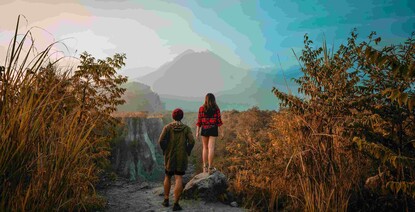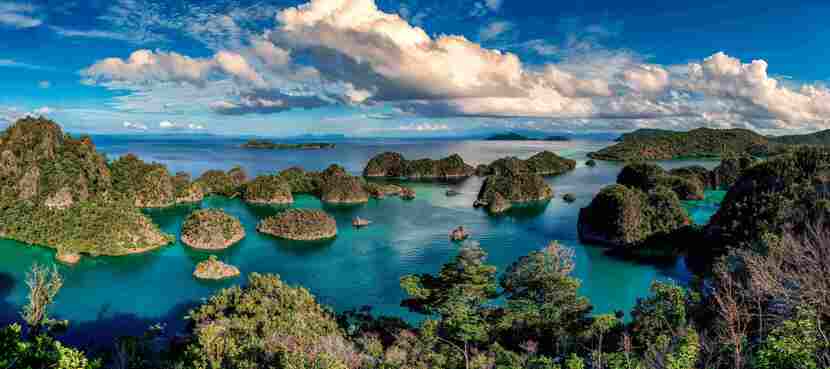Indonesia unquestionably stands out as an ideal destination for rejuvenation. The nation is adorned with National Parks showcasing stunning natural landscapes and serving as havens for protected biodiversity.
At present, Indonesia proudly hosts an impressive tally of 50 national parks. Notably, a number of these parks have attained the prestigious distinction of being recognized as UNESCO World Heritage Sites.
1. Komodo National Park
Photo: alinea.id
The Komodo National Park is situated in the Manggarai Regency, East Nusa Tenggara Province (NTT). This national park holds the prestigious designation of being a World Heritage Site and a Man and Biosphere Reserve, as declared by UNESCO in 1986.
Encompassing three main islands – Komodo, Rinca, and Padar – Komodo National Park is home to a diverse range of wildlife, including horses, wild buffaloes, deer, male wild boars, snakes, monkeys, and various bird species. Additionally, the park's waters house around 1,000 fish species, ten types of dolphins, seven whale species, 40 bird varieties, and green turtles.
Pink Beach on Komodo Island stands out with its pink-hued sand, a phenomenon attributed to microscopic organisms called Foraminifera, which impart a red pigment to the coral.
Renowned for its spectacular marine life, Komodo National Park boasts some of the world's best diving spots. Explore five destinations around the national park, including Loh Buaya, Pink Beach, Gili Laba, Kelor Island, and Komodo Village. The underwater wonders and breathtaking landscapes make Komodo a must-visit destination for nature and adventure enthusiasts.
2. Tangkahan National Park
Photo: Travelingyuk.com
Have you ever heard of Tangkahan ecotourism? Tangkahan Ecotourism is located in Namo Sialang Village, Batang Serangan District, Langkat Regency, North Sumatra.
You can reach this destination by taking the Medan-Binjai toll road, which takes about 3-4 hours. Positioned between two villages, Namo Sialang, and Sei Serdang, Tangkahan Ecotourism is renowned both locally and internationally for its unique charm. Interestingly, it's nestled within the expansive territory of the Gunung Leuser National Park.
This national park was designated by UNESCO as a World Heritage Site, the Tropical Rainforest Heritage of Sumatra, in 2004. It serves as a haven for Sumatran tigers, Sumatran rhinos, Sumatran orangutans, and Sumatran elephants.
Tangkahan protects nine endangered Sumatran elephants, but it offers more than that: a stunning, untouched 17,000-hectare rainforest adorned with ancient trees, wild primates like orangutans, waterfalls, caves, and hot springs.
Activities at Tangkahan Ecotourism include bathing with Sumatran elephants, tubing down the river, river bathing, camping in the designated grounds, and exploring natural caves. Come experience the allure of Tangkahan, where conservation meets adventure in the heart of Sumatra.
3. Tanjung Puting National Park
Photo: Traverse.id
Tanjung Puting National Park stands as both a conservation area and a proud natural attraction in Central Kalimantan. Located on the southwest peninsula, precisely in the Kumai District, this park in Central Kalimantan was initially designated as a nature reserve and wildlife sanctuary in 1936.
The Tanjung Puting Wildlife Sanctuary was included in UNESCO's list of Biosphere Reserves in Indonesia in 1977. Subsequently, in 1984, it attained the status of a national park.
Within its boundaries, Tanjung Puting harbors a diverse array of ecosystems, including tropical rainforests, lowlands, dryland forests, freshwater swamp forests, mangrove forests, coastal forests, and secondary forests. This national park is home to several protected species, including the endemic orangutan, proboscis monkey, red monkey, bear, deer, and wild cat. Tanjung Puting National Park is also the first orangutan rehabilitation center in Indonesia.
When you visit Tanjung Puting, explore notable sites like Tanjung Harapan, Pondok Tanggui, Camp Lakey, Natai Lengkuas, Danau Burung, and Sungai Buluh. To witness the entirety of Tanjung Puting National Park, plan your visit between June and September each year. Immerse yourself in the captivating biodiversity and conservation efforts of this remarkable destination.
4. Ujung Kulon National Park
Photo: Traveloka
Situated in the province of Banten, Ujung Kulon National Park has been designated as a UNESCO World Heritage Site since 1991, securing its status as a protected area. Ujung Kulon now serves as a conservation habitat for the critically endangered Javan rhinoceros, a species characterized by its single horn.
Furthermore, the park shelters other protected wildlife, including long-tailed macaques, wild boars, peafowls, Javan gibbons, and langurs. Within this national park, various forest types contribute to its rich biodiversity, encompassing coastal forests, mangrove forests, freshwater swamp forests, lowland tropical rainforests, and grasslands—all of which you can explore.
Experience the natural beauty of Ujung Kulon National Park by visiting key attractions such as Panaitan Island, Handeleum, and Peucang. Immerse yourself in the diverse ecosystems and rare wildlife that make this UNESCO-protected destination a treasure trove for nature enthusiasts.
5. Gunung Leuser National Park
Photo: https://id.m.wikipedia.org/wiki/Berkas:Hutan_Gunung_Leuser_Aceh.jpg
For adventure seekers who love the jungle wilderness, Taman Nasional Gunung Leuser in Aceh and North Sumatra beckons. A UNESCO World Heritage Site since 2004, this national park promises an exploration of pristine ecosystems ranging from coastal areas to high mountains, all enveloped by lush tropical rainforests.
Venture into Bukit Lawang and Tangkahan within Taman Nasional Gunung Leuser for an immersive experience. In Bukit Lawang, witness semi-wild rehabilitated orangutans in their natural habitat. Revel in the beauty of the forest panorama through trekking or the exhilarating activity of tubing, and navigating the river with an inflatable tube.
To reach Bukit Lawang, you can take ground transportation from the cities of Medan, Binjai, or Stabat. It's approximately 80 km from Medan, requiring a 3-4 hour journey. The entrance fee to Taman Nasional Gunung Leuser is IDR150,000 per foreign visitor and IDR5,000 per local visitor.
For those eager to explore Tangkahan, continue your journey from Bukit Lawang using private cars, travel services, or ojek (motorcycle taxi). The distance is around 50 km, and the trip takes 2-3 hours. Tangkahan entrance fees are IDR50,000 for foreign visitors and IDR10,000 for local visitors. Embark on a thrilling adventure, discovering the wonders of the Gunung Leuser National Park.
6. Kerinci Seblat National Park
Photo: Balisore
Taman Nasional Kerinci Seblat, the largest national park in Sumatra, spans across four provinces: West Sumatra, Jambi, Bengkulu, and South Sumatra. This vast expanse was designated a UNESCO World Heritage Site in the Asia-Pacific region in 2004, owing to its role as a sanctuary for around 4,000 plant species, including the iconic Rafflesia Arnoldii and Amorphophallus titanum.
Embrace the spirit of adventure as you trek through this diverse landscape, indulge in refreshing dips in natural hot springs, navigate meandering rivers, explore captivating caves, marvel at cascading waterfalls, and visit Southeast Asia's highest caldera lake, Danau Gunung Tujuh.
Are you ready to set your vacation agenda in these national parks? Discover more travel inspirations for thrilling adventures with #WonderfulIndonesia on Instagram @wonderfulindonesia.







